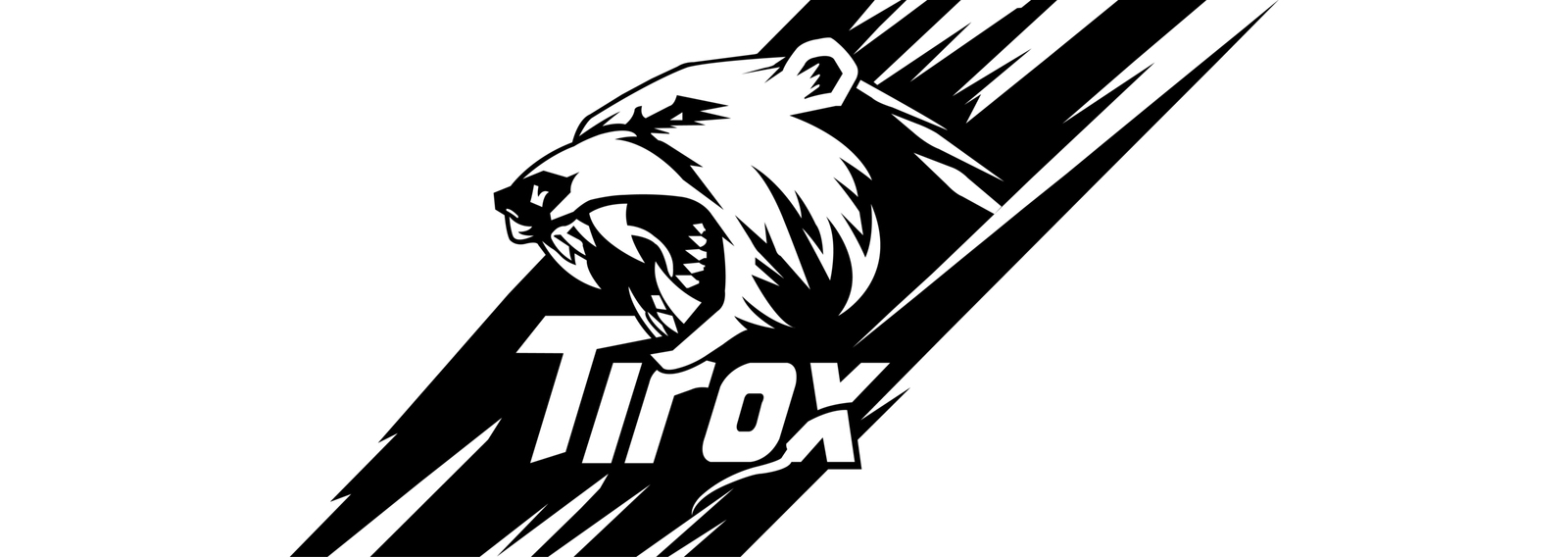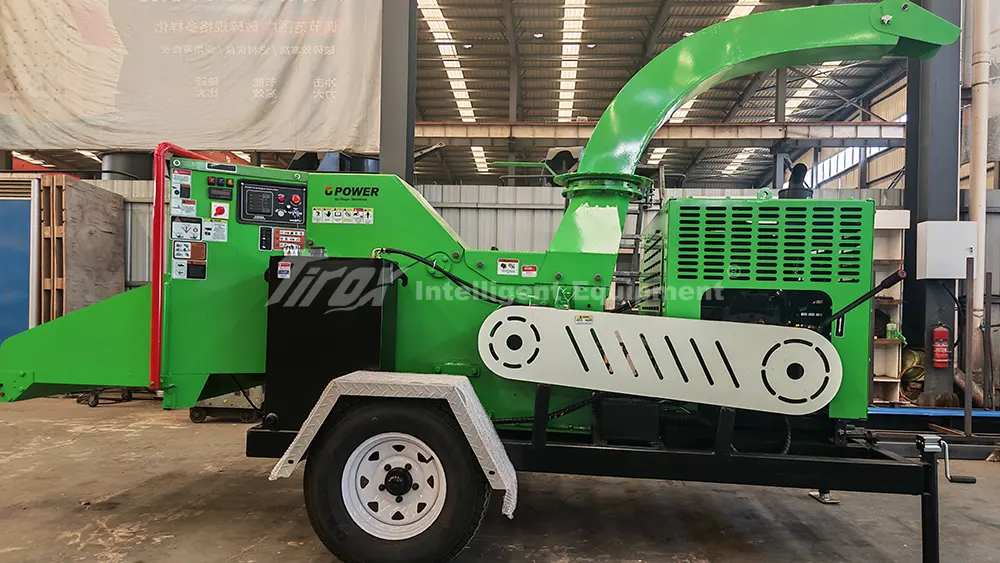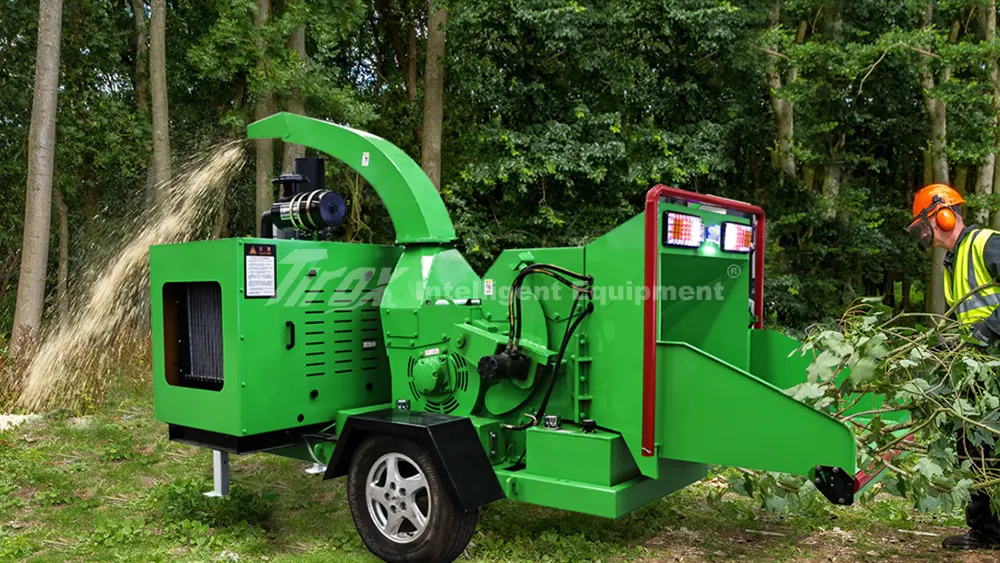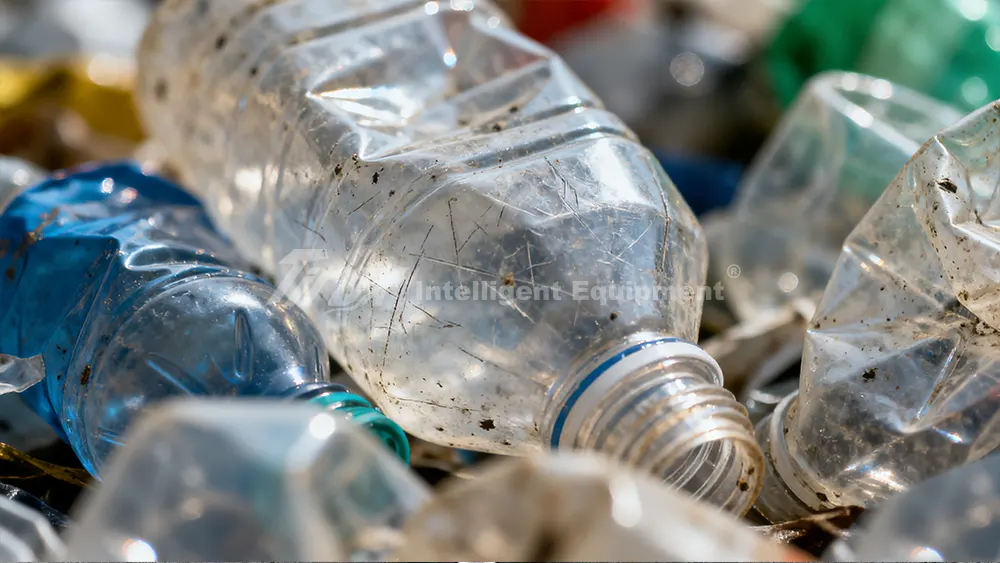You have a pile of rubber material and a powerful wood chipper. It is tempting to combine them. But before you do, stop and consider the consequences.
No, you cannot put rubber into a wood chipper. Wood chippers are designed with blades and mechanisms specifically for processing wood fibers, not elastic and abrasive materials like rubber. Attempting to chip rubber will likely damage the chipper’s components, create dangerous situations, and not produce suitable material.
Having worked for TIROX for 22 years, building and understanding wood processing machinery, I know the capabilities and limitations of these machines. Understanding these boundaries is critical for both the machine’s lifespan and your safety. Let us explore why rubber is a material best kept away from your wood chipper.
Can I shred rubber tires in a wood chipper for a horse arena?
Creating a soft, safe surface for your horse arena is important, and discarded rubber tires seem like a cost-effective solution. But is your wood chipper the tool to turn those tires into footing?
No, you cannot shred rubber tires in a wood chipper for a horse arena. Wood chippers are designed for organic, fibrous materials like wood, not dense, elastic, and abrasive rubber. Using a wood chipper on tires will damage the machine, possibly create hazards, and will not yield the finely shredded rubber needed for arena footing.
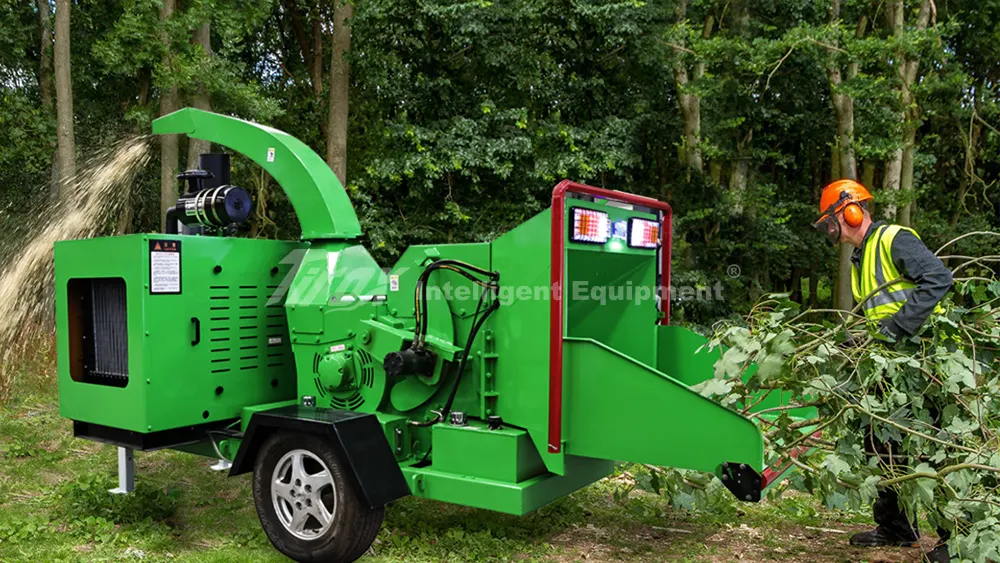
My 22 years at TIROX have given me a clear understanding of our machines’ capabilities. Our wood chippers, with cutting drums up to Φ800mm and rotation speeds up to 2800 rpm, are built for wood. Wood has a specific fibrous structure that shears and breaks cleanly under the force of the chipper’s blades (4 to 9 blades per drum). Rubber, especially from tires, is an elastic and tough material. Instead of cutting, it stretches, binds, and tears, placing extreme strain on the chipper’s engine and components. This difference is critical. Trying to feed a tire into a wood chipper will likely cause the rubber to wrap around the cutting drum or feed rollers, leading to severe jams that are dangerous and difficult to clear. I recall one incident where a customer tried to put a piece of heavy rubber sheeting into his chipper; the machine choked, and when inspected, the blades were completely dulled and some even chipped. The friction created by processing rubber can also generate significant heat, posing a fire risk within the machine’s confined spaces. Even our robust hydraulic forced feeder and intelligent feeding systems, designed to handle tough wood, are not equipped to overcome the unique resistance of rubber.
Material Properties Mismatch: Wood vs. Rubber
Wood chippers are engineered to exploit the fibrous nature of wood. Their blades are designed to shear and cut along the grain, efficiently reducing branches and logs into uniform chips. Rubber, by contrast, is highly elastic and non-fibrous. When subjected to the chipper’s blades, it tends to stretch and deform rather than break cleanly.
Mechanical Strain & Damage: Blades and Components
The elasticity of rubber puts immense stress on the chipper’s internal components. Instead of clean cuts, the blades encounter resistance that causes them to bind and rub, leading to rapid dulling, chipping, and even breaking. This directly impacts the lifespan of expensive parts like the cutting drum, blades, and even the engine itself.
Safety Hazards: Jams and Fire Risk
Rubber can easily wrap around the cutting drum and feed rollers, causing severe and dangerous jams. Clearing such a jam can be extremely hazardous. Additionally, the high friction generated by rubber rubbing against metal can lead to significant heat buildup, which poses a real risk of fire, especially in an enclosed machine with potential fuel sources.
| Feature | Wood Chipper Operation (Wood) | Result with Rubber Tires |
|---|---|---|
| Material Structure | Fibrous, cuts cleanly | Elastic, non-fibrous; stretches, tears, binds |
| Blade Interaction | Shears and breaks wood fibers | Dull, chips, or breaks blades; causes friction |
| Feeding Mechanism | Designed for rigid, irregular wood pieces | Wraps, jams, overloads system |
| Output | Consistent wood chips | Irregular, stringy, often dangerous debris |
| Operational Risk | Low for specified material | High risk of damage, fire, and injury |
What is the best way to shred rubber?
You have realized your wood chipper is not the answer for rubber. So, what is the right solution? How do specialists actually shred rubber into usable forms?
The best way to shred rubber, particularly tires, is by utilizing specialized industrial shredders, granulators, or cryogenic systems designed for rubber processing. These machines employ high-torque, low-speed tearing mechanisms or specific grinding processes that effectively break down the tough, elastic properties of rubber into desired sizes.
In my years at TIROX, I have learned that matching the machine to the material is paramount. For rubber, you need equipment built for its unique resilience. Industrial tire shredders are purpose-built machines that employ powerful, slow-rotating shafts with incredibly strong, interlocking blades. These blades are designed to literally rip and tear the rubber apart with immense force, often incorporating specialized materials to withstand the abrasion from steel belts within tires. Unlike our wood chippers, which rely on high-speed cutting, these shredders operate with high torque and low RPM, allowing them to overpower the rubber’s elasticity. After this initial shredding, the rubber often moves to granulators. Granulators further refine the material using precision cutting blades to reduce it into smaller, uniform crumbs or chips, which is ideal for applications like horse arena footing or playground surfaces. Some cutting-edge methods even include cryogenic shredding, where the tires are flash-frozen using liquid nitrogen. This makes the rubber brittle enough to be easily shattered into tiny pieces. These specialized systems also incorporate magnetic separators to remove any metal components, like steel cords, ensuring a clean rubber product. This multi-stage process ensures that the resulting rubber material is uniform, free of contaminants, and safe for its intended use. For any large-scale rubber processing, it is essential to seek out companies or facilities that own and operate this specialized equipment.
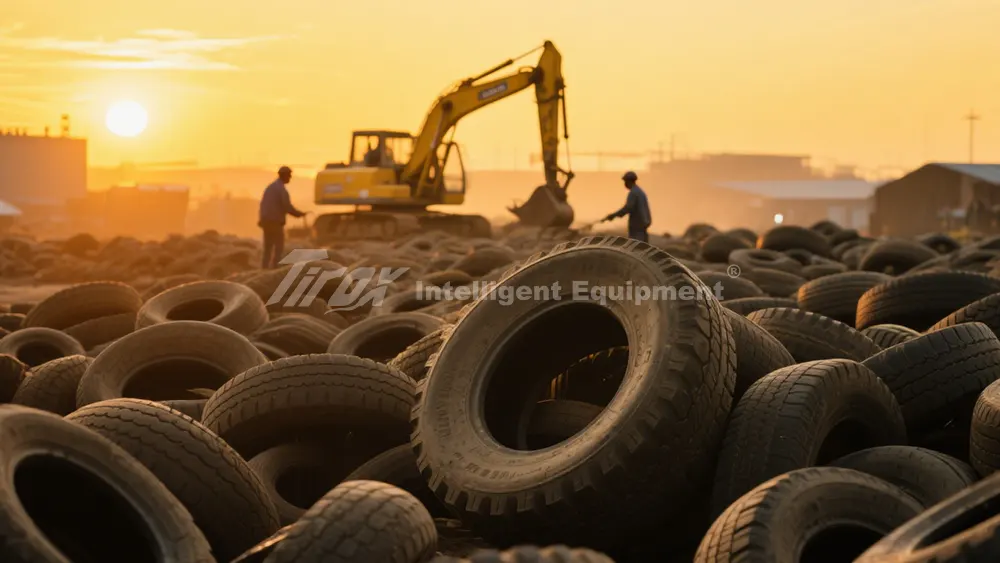
Specialized Machinery: Beyond Wood Chippers
Dedicated rubber processing equipment is fundamentally different from wood chippers. These machines are engineered to handle the unique elasticity, density, and abrasive nature of rubber. They prioritize sheer power and robust construction over the rapid, precise cutting action seen in wood chippers.
Mechanism Differences: Torque vs. Speed
Wood chippers use high-speed rotating drums and blades for quick, efficient cuts. Rubber shredders, conversely, operate at much lower speeds but generate enormous torque. This high torque allows them to overcome the rubber’s resistance by tearing and grinding, rather than attempting to cut it cleanly.
Multi-Stage Processing: From Shreds to Crumb
Processing rubber tires often involves multiple stages. First, large industrial shredders break down the whole tires into large shreds. Then, these shreds are further reduced by granulators or raspers into smaller, more uniform crumb rubber. Magnetic separators are crucial at various stages to remove steel wires, ensuring a pure rubber product.
| Equipment Type | Primary Mechanism | Ideal For | Key Difference from Wood Chipper |
|---|---|---|---|
| Industrial Shredder | High-torque, low-speed ripping | Initial breakdown of whole tires | Designed for elasticity and abrasion |
| Granulator | Precision cutting/grinding | Refining shredded rubber into crumb | Creates uniform, fine particles |
| Cryogenic System | Freezing then shattering | Producing very fine crumb rubber | Uses extreme cold to alter material properties |
| Magnetic Separators | Magnetic extraction | Removing steel belts from shredded rubber | Crucial for clean, usable rubber product |
What not to put in a wood chipper?
Knowing what to feed your wood chipper is as important as knowing what not to. Beyond rubber, what other materials can wreak havoc on your machine and pose a safety risk?
You should only put organic, untreated wood and branches into a wood chipper. Avoid feeding it materials like metal (nails, screws), rocks, plastic, glass, large amounts of dirt, or stringy items like vines. These non-wood materials can severely damage the chipper, dull its blades, cause dangerous projectiles, or lead to jams.
My 22 years at TIROX have reinforced the golden rule: wood chippers are for wood. Any deviation from this rule risks costly repairs and serious safety hazards. Metal, even small pieces like nails, screws, or rebar, is a prime example. The chipper’s blades, designed to shear wood, will be immediately dulled, chipped, or even shattered by metal. I have seen firsthand how a single forgotten bolt can bring a whole operation to a halt. Similarly, rocks, concrete, and any other non-organic hard materials can cause catastrophic damage to the cutting drum and blades, potentially sending dangerous projectiles flying. Our machines feature powerful cutting drums and feeding mechanisms , but they are not designed to withstand such impacts. Plastic and glass will not chip cleanly; instead, they will shatter into sharp fragments or melt and wrap around moving parts, creating impossible jams and a cleaning nightmare. Even too much dirt or mud on branches can be problematic, as it rapidly dulls the blades. Furthermore, long, stringy materials like certain vines or ropes can easily wrap around the feed rollers and cutting drum, causing severe clogs and strain on the engine. While our smart feeding control systems and forward-reverse-stop functions help manage wood, they cannot prevent damage from unsuitable foreign objects. Always perform a quick check of the material you intend to chip to ensure it is clean wood, free from contaminants.
Foreign Objects: Hard and Harmful
Introducing hard, non-organic items like rocks, concrete, or pieces of metal into a wood chipper is extremely dangerous. The high-speed rotation of the cutting drum can cause these items to be violently ejected, turning them into dangerous projectiles. Even if not ejected, they will cause severe damage to the chipper’s blades and internal components.
Non-Chippable Materials: Plastic, Glass, Stringy Items
Materials like plastic, glass, or certain types of fibrous vines simply do not chip like wood. Plastic and glass will shatter into hazardous fragments or, if soft, melt and stick to the chipper’s mechanisms. Stringy materials are notorious for wrapping around feed rollers and the cutting drum, leading to severe jams that are difficult and risky to clear.
Contaminants: Dirt and Mud
While wood chippers can handle a small amount of dirt, large quantities of mud or heavily soiled branches are problematic. The abrasive particles in dirt can rapidly dull the chipper’s blades, reducing efficiency and requiring more frequent maintenance. It can also lead to blockages and increased wear on moving parts.
| Prohibited Material Type | Specific Examples | Impact on Wood Chipper | Safety Risk |
|---|---|---|---|
| Metal | Nails, screws, rebar, tools | Dull/chip/break blades, damage drum | Projectiles, sparks, fire |
| Hard Non-Organics | Rocks, concrete, bricks, ceramics | Catastrophic blade and drum damage | Dangerous projectiles |
| Synthetics | Plastic, glass, fabric, rubber (non-tire) | Shatters, melts, wraps, jams, does not chip | Sharp shards, machine breakdown |
| Excessive Dirt/Mud | Heavily soiled roots, muddy branches | Rapid blade dulling, clogging | Reduced efficiency, higher wear |
| Fibrous/Stringy | Long vines, rope, electrical cords | Wraps around feed rollers and cutting drum, jams | Overheating, component failure |
| Treated Wood | Pressure-treated lumber (for some uses) | Release of toxic chemicals, unsuitable chip output | Environmental contamination, health risk |
| Oversized Material | Branches larger than specified inlet size | Causes jams, strains engine, can damage feed mechanism. | Machine breakdown, injury risk |
Conclusion
In summary, a wood chipper is specifically for wood. Attempting to chip rubber, especially tires, will damage the machine and is unsafe. For rubber, use specialized shredders. Always ensure you are only feeding organic wood into your chipper to maintain its function and your safety.
